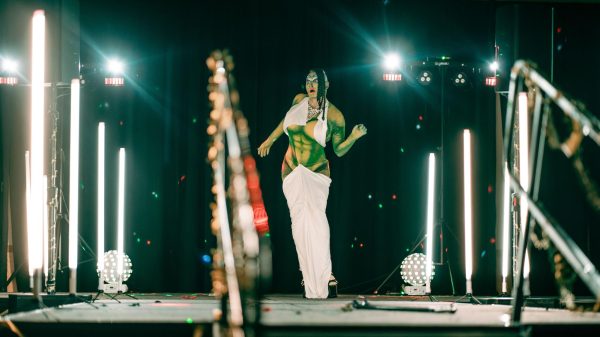“Red (Taylor’s Version)” Reclaims and Emboldens the Past

Taylor Swift has once again taken the world by storm with her release of “Red (Taylor’s Version),” a re-recording of her fourth studio album, which was first released in 2012. Along with the album, Swift has made several promotional appearances including two late night show interviews with Jimmy Fallon and Seth Meyers, a short film and a new music video. Simply put, it’s Red season.
Swift’s version of “Red” follows her release of “Fearless (Taylor’s Version)” in April and continues her vow to re-record her first six albums after her master recordings were sold to Scooter Braun and later Shamrock Holdings.
Associate Professor of Communications and Media Caitlin Carlson explained Swift’s efforts to regain control over her music. Carlson expressed hope that Swift’s work will shed light on an aspect of the music industry that isn’t widely known—most artists don’t own their work.
“My understanding was that she owns the copyright to the composition—the words and the notes—but not necessarily the performance rights,” Carlson said. “So by re-recording, she’ll now have the rights to both … I think she is also an advocate for artists. I know one of the issues that she was frustrated by was the way that young artists are often exploited in this way that they aren’t able to own the masters of their work, [the masters are] actually the property of the record company. By doing this, she was able to kind of shine a light on this issue and hopefully minimize the frequency with which it happens in the future for other artists.”
Carlson also spoke about how “Taylor’s Version” will add to Swift’s legacy, even after all she’s already accomplished.
“I think as a feminist, one of the things that’s really inspiring about her doing this is to reclaim ownership of the work that was always hers,” Carlson said. “She wrote the songs, she wrote the lyrics and now she’ll be able to decide when and how those songs are performed. And that, I think, is really incredible.”
Seattle U alumna, Frances Divinagracia, described how Swift has impacted her and why she keeps listening to her music.
“Swift changed everything about music for me,” Divinagracia wrote in a statement to The Spectator. “It’s also so rare to see a musician successfully jump between genres the way she has and she just gets better with every album she releases. I keep coming back to her because it’s undeniable how at her core, she’s an amazing storyteller and lyricist, and her fans understand that more than anything.”
“Red (Taylor’s Version)” built upon the 2012 release. While “Fearless (Taylor’s Version)” was meticulously re-recorded to match the original. Swift’s version of “Red” feels at times more like recreations, charmed with new-found freedom and enhanced by her current musical knowledge and matured vocals. It marks the growth of Swift, but also the growth of her fans.
“It’s very symbolic of how often I reflect on my own past,” Divinagracia wrote. “These re-recordings are very healing for my inner child, so I’m sure they are for her as well. The best thing about it is [that] I’ve gained a lot of life experience since the original album, especially in the heartbreak department, so I really do love being able to relate to her songs now and getting to scream them at the top of my lungs even more so.”
Third-year Sports and Exercise Science student Srinidhi Nanduri has been a Swift fan since her first record and shares how listening to “Red (Taylor’s Version)” has marked personal growth.
“It really has been a milestone,” Nanduri wrote in a statement to The Spectator. “I honestly go back to all those memories, good and bad, that have ties to each song. It reminds me how much I have proven myself and matured.”
In addition to “Red” featuring re-recordings of songs from her initial album, Swift included “From the Vault” songs. These tracks are offerings that she, for one reason or another, left off her nominated 2012 Grammy Album of the Year “Red.”
Some songs have been heard before. Swift originally gifted “Better Man (Taylor’s Version)” to Little Big Town, and “Babe (Taylor’s Version)” was given to Sugarland to record. There are hidden gems among the new offerings that bear connection to past and future work.
“Nothing New (feat. Phoebe Bridgers) (Taylor’s Version)” is a quiet, contemplative and confessional duet about the insecurity of losing the limelight and sparkle of youth—a track that seemingly hints at the other side of “The Lucky One.”
“Message in the Bottle (Taylor’s Version)” and “The Very First Night (Taylor’s Version)” are glittering, addictive pop hits that would have been smashes in 2012. Here, the songs act as precursors for the sound she would fully embrace in her follow-up mega-album, “1989,” which will also receive a fresh new sound on a re-recorded version.
Swift’s “I Bet You Think About Me (Taylor’s Version),” which features Chris Stapleton, is a sharp-witted country song that scorns an ex who she reflects will still remember her. The music video, which featured the directorial debut of her good friend Blake Lively, sees an old flame on his wedding day envisioning Swift in multiple bright-red outfits as she galivants around the occasion. The video sparked quite a reaction online as Swifties searched for Easter eggs from Swift, who is notorious for leaving clues about future projects.
Finally, there’s the song to end all songs. In an epic album closer, Swift sings the ten minute version of “All Too Well,” a song that critics and fans alike have long held as her greatest work. If it’s possible, her magnum opus gets even better, sharper and more painful as Swift paints the all too vivid picture of a sweet-loving relationship turned tumultuous.
On The Tonight Show Starring Jimmy Fallon, Swift expressed her excitement for this version of the song and thinks it’ll become the new standard version for her fans. On her second appearance of the night, on the Late Night with Seth Meyers, Swift explained why she’s going the extra mile for fans as she re-records.
“Going back and reliving these things with the fans, and this time around, I get to do the things that I know they wish I would have done the first time,” Swift said to Meyers. “I’m always listening to their opinions and their theories … and they will let me know which songs should have been singles. They let me know which songs did not get videos and should have gotten videos! And you know what … I’m listening and I’m making the videos and doing the things.”
Swift has done what she has promised. Swift released the “All Too Well: The Short Film,” a fifteen-minute video featuring the ten minute version of the classic song. Sadie Sink and Dylan O’Brien embody the younger version of the couple Swift sings about. Directed and written by Swift, the long-lost relationship is separated into parts, which is later revealed to be chapter titles to the book that Swift wrote as an adult.
All her new content has left Swifties wondering what her next project is. Divinagracia is expecting that Swift will re-record “1989” since she’s already released “Wildest Dreams (Taylor’s Version)” following a TikTok trend. Nanduri anticipates that “Speak Now” will be the next re-record as Swift teased it on the price tag of signed “Red (Taylor’s Version)” CD’s.
The dueling theories have been played out in Swift’s Easter eggs. The concept of the “I Bet You Think About Me” music video is a nod to the title track of Swift’s third album, “Speak Now,” in which she imagines wrecking the wedding of a former beau, which has fans wondering if that will be her next stop on her road towards ownership of her work.
There are also clues to Swift’s “1989.” In one of the opening sequences of the music video, Swift replaces a white flower with a red rose—an action that seems to reference the 1951 Disney animated film “Alice in Wonderland” and the song “Painting the Roses Red.”
The reference is a significant one. On the deluxe edition of “1989,” Swift has a song called “Wonderland,” which includes lyrics inspired by the animated film. Elsewhere in the video, a wedding cake that Swift smashes has the numbers 13 and 26 decorated on it.
The number 13 is an obvious reference to Swift’s favorite number, but 26 seems to be more significant than just twice her favorite number. First off, the animated film “Alice in Wonderland” was released on July 26, 1951, but even more intriguing is that the Lewis Carroll children’s book was originally published on Nov. 26, 1865.
The anniversary of the beloved children’s book is just around the corner and lands on a Friday, the day on which artists typically release their work. Additionally, a cover of “Alice in Wonderland” bears an eerie resemblance to the cover of Swift’s “All Too Well” book that she writes at the end of the “All Too Well: The Short Film.”
While Swift’s next re-recorded album is greatly anticipated, the focus stays on “Red (Taylor’s Version).” The album, an expanded version of the original, is an impressive example of the power of Swift, a mark of her growth and a testament to her music. “Red (Taylor’s Version)” expands on her past and emboldens it—in burning red.









